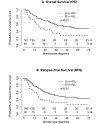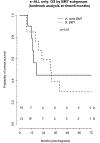Secondary acute lymphoblastic leukemia, a retrospective analysis from Washington University and meta-analysis of published data
- PMID: 30114560
- PMCID: PMC7735253
- DOI: 10.1016/j.leukres.2018.07.024
Secondary acute lymphoblastic leukemia, a retrospective analysis from Washington University and meta-analysis of published data
Abstract
Secondary acute lymphoblastic leukemia (s-ALL) is rare and poorly defined and data regarding outcomes post-transplant are lacking. Here, we report a detailed analysis of s-ALL at our Institution. Among 211 eligible patients with ALL from 2006 to 2017, 30 (14%) were defined as s-ALL and the remaining as primary ALL (p-ALL). s-ALL patients were older and had higher incidence of adverse risk factors. Overall response (OR) after induction was not different between s-ALL and p-ALL (79% versus 90% respectively, p = 0.106). S-ALL group had a higher risk of relapse (RFS) and death (RFS HR = 1.93, 95% CI 1.2-3.12, p = 0.007. OS HR: =1.95, 95% CI 1.18-3.23, p = 0.01). In multivariate analysis, the adverse effect of s-ALL on RFS and OS was no longer significant, however a pooled meta-analysis of our and published data indicated that s-ALL is an independent risk factor for lower OS (HR: 1.30, 95% CI: 1.11-1.52, p < 0.01). Myeloablative allogeneic transplantation in s-ALL was associated with lower rates of relapse and higher transplant related mortality without improvement in OS. These data indicate that s-ALL status should be considered for risk- stratification of newly diagnosed ALL. The optimal conditioning regimen for s-ALL patients undergoing allogeneic stem cell transplantation needs to be evaluated in a larger study.
Keywords: Secondary acute lymphoblastic leukemia; Stem cell transplantation; Therapy-related acute lymphoblastic leukemia; Transplant related mortality.
Copyright © 2018 Elsevier Ltd. All rights reserved.
Conflict of interest statement
Figures



Similar articles
-
Survival outcomes in secondary and primary acute lymphoblastic leukemia: a systematic review and meta-analysis.Sci Rep. 2025 Jun 2;15(1):19282. doi: 10.1038/s41598-025-95356-5. Sci Rep. 2025. PMID: 40456857 Free PMC article.
-
Allogeneic Stem Cell Transplantation versus Tyrosine Kinase Inhibitors Combined with Chemotherapy in Patients with Philadelphia Chromosome-Positive Acute Lymphoblastic Leukemia.Biol Blood Marrow Transplant. 2018 Apr;24(4):741-750. doi: 10.1016/j.bbmt.2017.12.777. Epub 2017 Dec 13. Biol Blood Marrow Transplant. 2018. PMID: 29247779 Clinical Trial.
-
Similar survival for patients undergoing reduced-intensity total body irradiation (TBI) versus myeloablative TBI as conditioning for allogeneic transplant in acute leukemia.Int J Radiat Oncol Biol Phys. 2014 Jun 1;89(2):360-9. doi: 10.1016/j.ijrobp.2014.02.032. Epub 2014 May 5. Int J Radiat Oncol Biol Phys. 2014. PMID: 24837891
-
Measurable residual disease at myeloablative allogeneic transplantation in adults with acute lymphoblastic leukemia: a retrospective registry study on 2780 patients from the acute leukemia working party of the EBMT.J Hematol Oncol. 2019 Oct 23;12(1):108. doi: 10.1186/s13045-019-0790-x. J Hematol Oncol. 2019. PMID: 31647022 Free PMC article.
-
Comparative study on allogeneic with autologous hematopoietic stem cell transplantation in adult patients with Philadelphia chromosome-positive acute lymphoblastic leukemia in the era of TKIs: a systematic review and meta-analysis.Ann Hematol. 2020 Nov;99(11):2619-2628. doi: 10.1007/s00277-020-04258-1. Epub 2020 Sep 22. Ann Hematol. 2020. PMID: 32960314
Cited by
-
Survival outcomes in secondary and primary acute lymphoblastic leukemia: a systematic review and meta-analysis.Sci Rep. 2025 Jun 2;15(1):19282. doi: 10.1038/s41598-025-95356-5. Sci Rep. 2025. PMID: 40456857 Free PMC article.
-
Allogeneic hematopoietic cell transplantation is equally effective in secondary acute lymphoblastic leukemia (ALL) compared to de-novo ALL-a report from the EBMT registry.Bone Marrow Transplant. 2024 Mar;59(3):387-394. doi: 10.1038/s41409-023-02192-0. Epub 2024 Jan 9. Bone Marrow Transplant. 2024. PMID: 38195982
-
Therapy-related acute lymphoblastic leukemia is a distinct entity with adverse genetic features and clinical outcomes.Blood Adv. 2019 Dec 23;3(24):4228-4237. doi: 10.1182/bloodadvances.2019000925. Blood Adv. 2019. PMID: 31869410 Free PMC article.
-
Common B-cell acute lymphoblastic leukaemia in a 70-year-old woman presenting 2 years after carboplatin-taxane radiotherapy for endometrial cancer.Ecancermedicalscience. 2019 Oct 29;13:972. doi: 10.3332/ecancer.2019.972. eCollection 2019. Ecancermedicalscience. 2019. PMID: 31921343 Free PMC article.
-
Synchronous B-Cell Acute Lymphoblastic Leukemia and Serous Ovarian Carcinoma: A Case Report.Case Rep Oncol. 2021 Nov 12;14(3):1621-1626. doi: 10.1159/000519743. eCollection 2021 Sep-Dec. Case Rep Oncol. 2021. PMID: 34950006 Free PMC article.
References
-
- Kayser S, et al. The impact of therapy-related acute myeloid leukemia (AML) on outcome in 2853 adult patients with newly diagnosed AML. Blood 117, 2137–2145 (2011). - PubMed
-
- Schoch C, Kern W, Schnittger S, Hiddemann W. & Haferlach T. Karyotype is an independent prognostic parameter in therapy-related acute myeloid leukemia (t-AML): an analysis of 93 patients with t-AML in comparison to 1091 patients with de novo AML. Leukemia 18, 120–125 (2004). - PubMed
-
- Ganzel C, et al. Secondary acute lymphoblastic leukaemia is constitutional and probably not related to prior therapy. Br J Haematol 170, 50–55 (2015). - PubMed
-
- Giri S, et al. Secondary acute lymphoblastic leukemia is an independent predictor of poor prognosis. Leuk Res 39, 1342–1346 (2015). - PubMed
Publication types
MeSH terms
Grants and funding
LinkOut - more resources
Full Text Sources
Other Literature Sources
Miscellaneous

